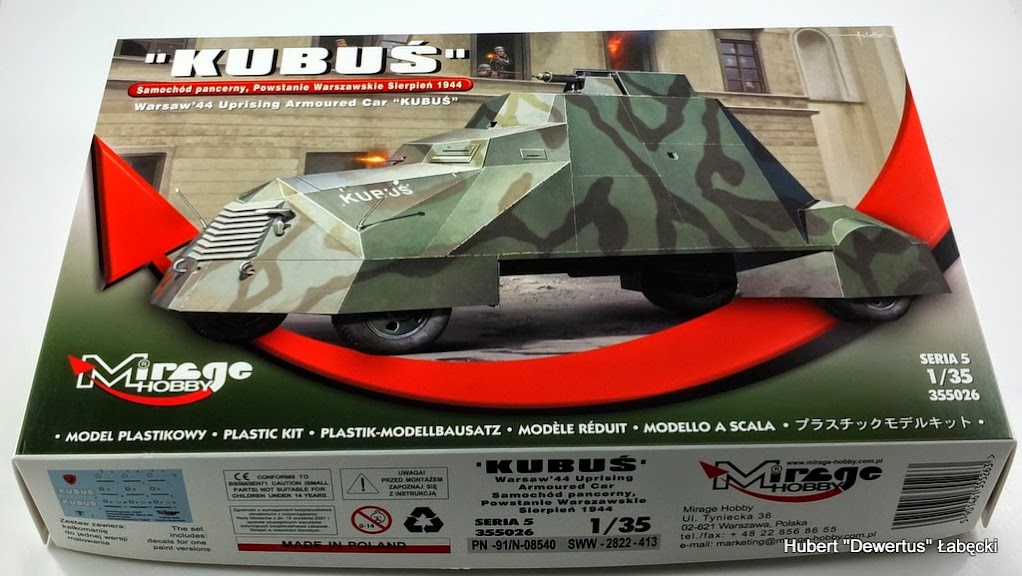The Warsaw Uprising is an relatively unknown episode of the Second World War (except of course Poland where is seen as one of the most dramatic and heroic events in national history). Therefore the theme of the Warsaw Uprising is extremely rare presented by modelers and producers. Issuance just before the 70 anniversary of Warsaw Uprising the model of "iconic vehicle" of the Polish Underground Army (Armii Krajowej) is a real gift offered to us by Mirage Hobby.

Historic background
The vehicle were constructed in Warsaw in the first decade of August 1944 through the efforts of the team of technicians and workers led by Eng. Valerian Bielecki, ps. "John". On the chassis of a Chevrolet truck Model 155 fuselage fitted a double cuirass made from steel sheet (part of them was took from captured german CIT vehicle (also Chevrolet 155)) to protect against arms fire only. Armored car "Kubuś" was conceived as a assault groups (consisting of 8-12 soldiers transport) vehicle armed in 1-2 machine guns and flamethrower. After the construction the vehicle was drafted into the motorized columns "Otter" lead by Lt. Waclaw Jastrzębowski "Aspiry". "Kubuś" with "Grey Wolf" (other insurgent vehicle: captured armored personnel carrier Sd.Kfz.251/3 Ausf.D ) took part in attempts to gain the Warsaw University at August 23th and September 2nd 1944. 6th September 1944, in day of withdrawal the troops insurgent groups "Krybar" from the Powisle (city district on the left bank of the river, bordering with: City Center (west), Old Town (north), Mokotów (south), in the absence of the possibility move to the City Centre, the crew of "Kubuś" has damage the vehicle to prevent use them by Germans. In 1945 he was transferred to the Polish Army Museum (it was a miracle that it wasn't destroyed during the "Stalin's" time).
------------------------------------

Source: Wikimedia
The kit
Parts are placed on four frames casting from gray plastic. Items are cast clean, with no shifts or deficiencies. Panel lines are delicate and engraved.


The tires are made from rubber.

The quality and the details of elements are very good and indicates the constantly improved manufacturer's precision and detailing. The quality of the plastic also makes the most positive impression.


At first view, the decals looks good - they are delicate, clearly and cleanly printed.

The instructions has been printed on two sheet - first is in A4 size and is printed in color (first page including history of "Kubuś", secnd is a painting scheme.

Second sheet is a clasic assembly instruction presented clearly and logically - this time Mirage resigned from 3D graphics.

Is it recommended? Definitely yes!

Historic background
The vehicle were constructed in Warsaw in the first decade of August 1944 through the efforts of the team of technicians and workers led by Eng. Valerian Bielecki, ps. "John". On the chassis of a Chevrolet truck Model 155 fuselage fitted a double cuirass made from steel sheet (part of them was took from captured german CIT vehicle (also Chevrolet 155)) to protect against arms fire only. Armored car "Kubuś" was conceived as a assault groups (consisting of 8-12 soldiers transport) vehicle armed in 1-2 machine guns and flamethrower. After the construction the vehicle was drafted into the motorized columns "Otter" lead by Lt. Waclaw Jastrzębowski "Aspiry". "Kubuś" with "Grey Wolf" (other insurgent vehicle: captured armored personnel carrier Sd.Kfz.251/3 Ausf.D ) took part in attempts to gain the Warsaw University at August 23th and September 2nd 1944. 6th September 1944, in day of withdrawal the troops insurgent groups "Krybar" from the Powisle (city district on the left bank of the river, bordering with: City Center (west), Old Town (north), Mokotów (south), in the absence of the possibility move to the City Centre, the crew of "Kubuś" has damage the vehicle to prevent use them by Germans. In 1945 he was transferred to the Polish Army Museum (it was a miracle that it wasn't destroyed during the "Stalin's" time).
------------------------------------

Source: Wikimedia
The kit
Parts are placed on four frames casting from gray plastic. Items are cast clean, with no shifts or deficiencies. Panel lines are delicate and engraved.


The tires are made from rubber.

The quality and the details of elements are very good and indicates the constantly improved manufacturer's precision and detailing. The quality of the plastic also makes the most positive impression.


At first view, the decals looks good - they are delicate, clearly and cleanly printed.

The instructions has been printed on two sheet - first is in A4 size and is printed in color (first page including history of "Kubuś", secnd is a painting scheme.

Second sheet is a clasic assembly instruction presented clearly and logically - this time Mirage resigned from 3D graphics.

Is it recommended? Definitely yes!
